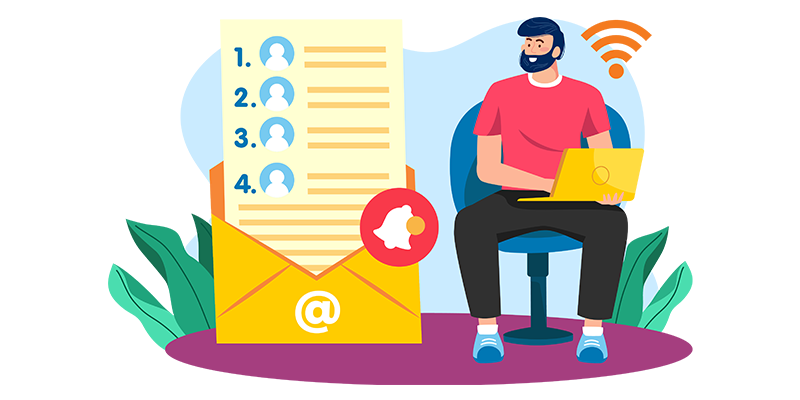Marketing is going through some exciting changes. Your business can now advertise on TikTok and pay micro-influencers to promote your products. You can even use artificial intelligence to create entire ad campaigns from scratch. However, no matter which new marketing strategy you choose, one classic technique can work with AI or on its own to make your entire marketing plan profitable.
Not much has changed for emails, and that’s a good thing!
Email has remained essentially unchanged since its early days, with the format resembling snail mail. However, this lack of change is actually a hidden strength. Consider the constant updates and changes with other platforms, such as Facebook ads and the latest social media trends. In contrast, email provides reliable and predictable communication that is still remarkably profitable. Its consistent format allows us to focus and concentrate on what matters most.

The latest statistics indicate that investing one dollar in email marketing can return an average of forty-four dollars. Returning visitors to your website are worth eight times more than first-time visitors, so bringing people back to your website, social media, and content is essential.
Building an email list and nurturing it with the right kind of emails every week is the best way to do this. In this article, I will share the email marketing plan I’ve used for years. It has helped me grow my business beyond my expectations; anyone, even beginners, can master it. I’ll guide you through everything you need to know from start to finish. However, to make email marketing work for you, you need people to send these emails to.
You Can’t Send Emails Without a List
Let’s start with building your email list. However, before we discuss building your list, let’s review why you should never purchase an email list. Firstly, many of the email addresses you would buy may need to be updated. Secondly, the recipients of these emails have yet to show any interest in hearing from you, so they may not read your emails or may mark them as spam.
If too many people mark your emails as spam, email providers such as Gmail will filter all your emails into the spam folder. Therefore, you need to get people to willingly opt-in for your emails. To do this, you need to create valuable content that is engaging, and people will want to provide their email addresses to receive it.

Build an Organic Email List with Powerful Lead Magnets
This piece of content is commonly referred to as a lead magnet, lead generator, or freebie. The type of freebie you choose to create can significantly impact the growth of your email list. To help you out, let’s discuss what kinds of freebies work well and what types do not.
Regarding lead magnets, offering something that promises a specific result can be more effective than a simple newsletter. A guide that promises to transform something, such as training your dog in two weeks with a step-by-step plan, is more compelling than just offering a list of five things to know when teaching a new dog. It would help to choose a topic that overlaps with your paid offer to make sure your lead magnet makes perfect sense.
For example, if you’re a dog trainer, a training guide would work well as a lower-level version of what you charge for. However, a guide about choosing the right puppy wouldn’t serve as a good enough bridge between the freebie and the paid service. The main takeaway is to focus on providing something that offers a specific transformation rather than just information.
Uniting Landing Pages with Irresistible Lead Magnets
You can use free and paid traffic to attract visitors to your website. A freebie is a great way to get people interested in your content. To make it easy for visitors to opt in, you can add a dedicated landing page focusing solely on your freebie. The landing page should have a catchy title, a brief description, a simple form that asks for the visitor’s first name and email address, and some bullet points to arouse curiosity. This simple formula can help you generate up to 600 new monthly leads.
To improve your opt-in rates, you should also add the same top section of your landing page to every page of your website. Repetition is vital to getting more sign-ups; you never know which pages visitors will see. Finally, you can also add an exit intent pop-up to your site-wide page that will appear when the visitor is about to leave your website. This last-chance offer can increase your opt-in rates by an additional 10 to 15 percent.
The next step is to increase the traffic to the dedicated landing page on social media. If you have a strong presence and many followers, you should post regularly about the lead magnet and provide a direct link to the opt-in page. If the opt-in page is converting well, it is also recommended that paid ads are run on it. You can do this on almost every major platform, such as Facebook, Instagram, Pinterest, and TikTok. Whether people opt-in from your organic posts or paid ads, the process is the same – they enter their email, and your email provider (such as MailChimp) will automatically send your freebie to your new subscribers in real-time.

Nurture Your Mailing List
Now that we’re actively growing your email list daily, it’s time for the next step: caring for your list. Getting that email address is only the beginning. You’re not just collecting them for a rainy day. You aim to nurture every single lead you get with the right kind of emails and on the proper schedule.
I often hear people say that email marketing doesn’t work. But in reality, it just means that these emails don’t work on them. And they’re right! There will need to be more than just promotional emails alone. The key to achieving the 44 times ROI I promised at the beginning of this article is by sending helpful emails that people want to open, and THAT increases their desire for your paid offer. Instead of bombarding your list with promotion after promotion, coupon after sale, and all your new arrival products, I recommend giving them items of value at least three times before ever asking for a sale.
Case Studies and Customer Success Stories
Using stories or case studies to illustrate your point is a guaranteed method to enhance the engagement of your emails and foster deeper connections with your audience. The main objective of storytelling in marketing and sales is to avoid directly pointing out the customer’s flaws, issues, or needs. Instead, by sharing a story, you can make your message more relatable and engaging.
When your audience reads your story, they are likely to imagine themselves in that story, which makes it easier for them to understand your message and relate to it. So, next time you’re crafting your emails, consider using storytelling to connect with your readers and build a stronger relationship with them.
If you’re running a service business, there are several actionable ways to use storytelling in your emails. One approach is to share a story about how you solved a problem for a client. Keep the pitch to a minimum and end with a question encouraging the reader to think about how the story might affect them.
In addition to solving problems, you can also use stories to share valuable lessons that you or your clients have learned. While you can occasionally include case studies that show proof and include a call to action, it’s important to strike a balance between sharing stories and making a pitch.
Embracing the idea of less being more, even in email sends
Multiple email providers advocate for their elaborate HTML templates, which are purported to enhance the professionalism of your business. However, these templates often give off a salesy vibe, potentially relegating your emails to the promotions tab or even the dreaded spam folder, thus diminishing their visibility and readership. Surprisingly, the most effective approach to email communication involves forgoing templates altogether.
Plain text emails possess a distinct advantage by seamlessly blending in with personal correspondence, which tends to be more favorably received. Nonetheless, not using templates doesn’t equate to sacrificing professionalism.
Here are some strategies to maintain a polished and enticing appearance: employ concise paragraphs and ample line breaks, emphasize key phrases with bold text, incorporate emojis judiciously, and utilize bullet lists where appropriate. Following these guidelines will ensure that your emails captivate your audience’s attention for longer.
Emails resemble websites because people tend to skim rather than read them thoroughly. Therefore, ensuring that your emails are formatted for easy skimming is crucial. Regarding tone, every business varies, but generally speaking, your emails should adopt a conversational and friendly approach, fostering a one-to-one connection.
Emails aren’t formal essays, and overly rigid writing won’t leave a lasting impression or advance the relationship. Authenticity is paramount; customers prefer engaging with real people rather than faceless corporations or bureaucratic language. Therefore, your language plays a significant role in building trust and rapport with your audience.